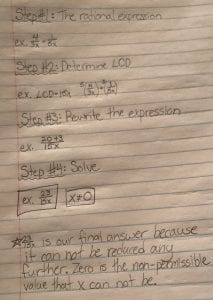This week in Pre Calc 11 we learned how to add, subtract, divide and multiply rational expressions. We also learned how to determine non-permissible values of rational expressions. In class this week, we reviewed that a rational expression is an algebraic expression that can be written as the quotient of two polynomials. Rational expressions can not have a denominator of zero, therefore the variable in the denominator can not make the denominator equal to zero. The values for the variable that make the variable equal to zero are called the non-permissible values. We may have to factor out the denominator, to be able to determine the non-permissible values.
To multiply rational expressions, we can either multiply straight across, meaning that we multiply the numerators together and the denominators together and then simplify or we may simplify first so that the numbers and variables that we are working with are smaller. For example, in the expression I would first simplify the expression, by eliminating the
from the numerator and denominator of this expression and I would also simplify the
and
to become
and
Leaving me with the newly simplified expression,
Next we are able to multiply straight across giving us our final answer:
This is our final answer because it can not be simplified any further.
To divide rational expressions, we must first flip the numerator and the denominator of the second fraction, then we are able to simplify and then multiply straight across. When writing the non-permissible values of a rational expression that requires division, we must indicate all of the values that the variables can not be, meaning the ones that were in the denominator before it was reciprocated, as well as after.
To add and subtract rational expressions we must first determine the lowest common denominator and then rewrite the fractions as one big fraction, using the lowest common denominator. We may only add or subtract the numerators, the common denominator remains the same. Once we have determined our final answer and reduced it, we must state the non-permissible values.
I have included an example below that shows the detailed steps I would take when adding rational expressions and how to state the non-permissible values.
